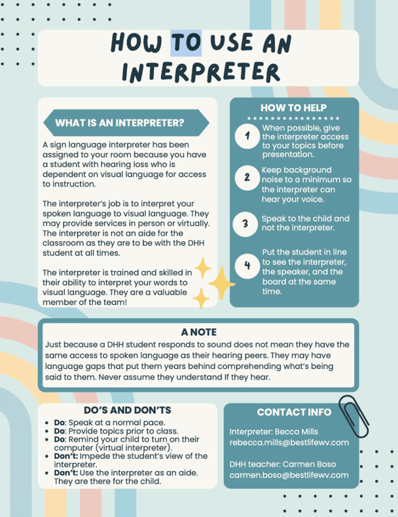This blog is focused as a quick guideline for parents, teachers, therapists, or any professional who will be working with a sign language interpreter.
If you walked in and thought, “Who is that, why are they here, why are they in my space, and what are they doing with their hands?” This quick read is definitely for you.
To begin with, interpreters are individuals first and foremost, and in most cases, they are more than willing to explain or address any questions you might have about collaborating effectively. Don't hesitate to inquire about how you can facilitate a smoother transition. We understand that having an additional person in your environment can sometimes feel awkward. However, it's important to remember that each situation is distinct. A classroom, a living room, and a doctor's office will each have their own unique dynamics, so keep this in mind as I guide you through some general guidelines.
ASL Interpreters are trained in English, American Sign Language, and related cultures. They convey messages in a culturally appropriate way, not just word-for-word. Interpreters are certified to handle various topics and settings in both languages. Their aim is to make communication seamless. Special certifications exist for complex fields like medical or legal. Check the public registry for certification details if needed.
A sign language interpreter is required by federal law to be provided for any business, building or service provider that is open to the public. This includes schools, doctors offices, court, concerts, or any service provider. The deaf or HH (hard of hearing) consumer is never responsible for providing their own interpreter. The company or business providing the service must provide a qualified interpreter at the request of the consumer.
Who is deaf or HH? This part I felt important to include because many deaf or HH people have some residual hearing, meaning they can hear some sounds. They may also use a hearing aid or have a cochlear implant that helps them hear more sounds. They may also use their own voice to speak. This can sometimes lead people to believe that they can understand fully without the assistance of an interpreter.
Who said they needed to be here? That is never for anyone to determine but the consumer themselves. Again, each setting and situation is unique, and in some settings an interpreter may not be necessary, but the consumer will be the one to decide. A business or service provider should never tell a consumer they won’t need an interpreter. Even if the material is presented in writing or providing closed captions. Remember that the interpreter is delivering the message in the best way it can be understood, and will not always look the same as it does in English.
What can I do? Great question! ASL is often not the interpreter's first language, so they prepare for each assignment. Preparation varies but may include reviewing notes, consulting others, or watching relevant videos. If you're a teacher, speaker, or provider, it's helpful to give the interpreter any materials in advance, like visuals, scripts, or notes, to ensure clear communication.
They are here, now what? For a deaf or HH consumer to fully understand, they need to see both the interpreter and speaker simultaneously. This allows them to catch body language and facial expressions without missing spoken words. The consumer decides the best spot for the interpreter, usually near the speaker, in good lighting, and visible to any visuals like a PowerPoint. Speak naturally to the consumer, using "you" instead of referring to them indirectly. Pause if needed when asking questions. Avoid side conversations with the interpreter, as they must relay everything to the consumer. If using a virtual interpreter, ensure the consumer can see their screen, materials, and speaker without turning away.
Easy, right? Now that you know, it is not so scary. An interpreter is bound by a code of ethical confidentiality, and should never discuss what or who they interpret for outside of the assignment. Please feel comfortable to deliver your message directly as you would to any hearing person. We do know it can be a lot to remember, and a little intimidating, so don’t be afraid to ask again. We are both working toward the same goal of delivering your message with your intent. With your help, we can produce a more synergistic outcome.
This is an example visual created by a DHH teacher at our school that she provided to the teachers:

Author: Rebecca Mills, BEI Certified American Sign Language Interpreter


